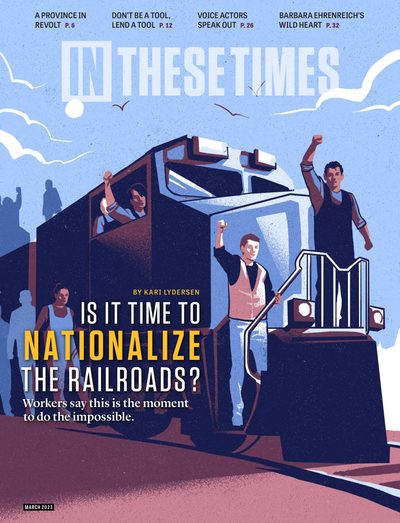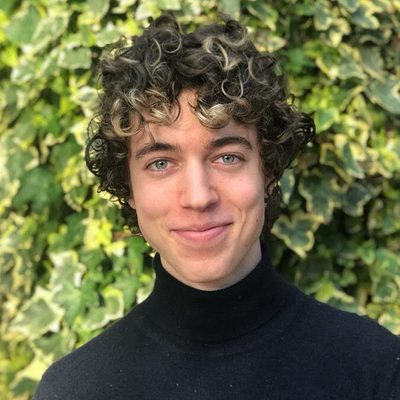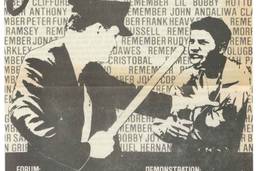Anime Voice Actors Speak Out: It’s Not Kawaii When We Aren’t Paid
The union drive in anime dubbing.
Rohan Montgomery
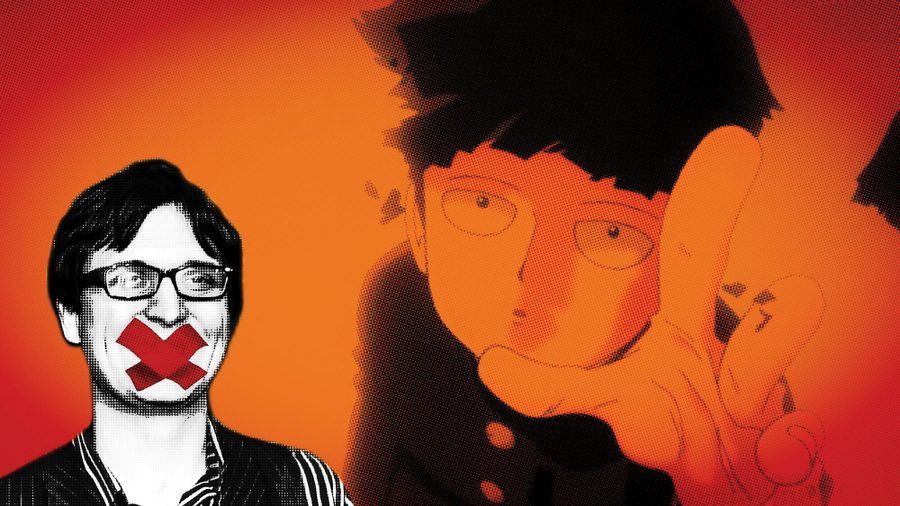
On Sept. 20, 2022, Kyle McCarley, an experienced and well-respected voice actor, had bad news to tell his fans. He had been approached by Crunchyroll, the leading distributor of anime in the United States, to reprise his leading role as Shigeo “Mob” Kageyama, an awkward boy with immense psychic powers, for the popular Mob Psycho 100—but without a union contract.
At the suggestion of a castmate, the vocally pro-union McCarley offered to accept that nonunion contract on the condition that Crunchyroll would have a good-faith discussion with SAG-AFTRA, the union for voice actors. “It felt like such a small concession,” McCarley tells In These Times. “I was like, ‘They’d be crazy not to take this.’”
They didn’t take it.
So McCarley — despite being offered more than he would have made with a union contract — walked away, as did several castmates. They were promptly replaced with other actors and, despite outrage from the infamously passionate anime community, the show went on.
“It seems like their plan is to just weather the storm and wait until people get tired of talking about it,” says McCarley. The problem, he thinks, isn’t money: “It very much feels like an ideological issue for them.” Crunchyroll did not respond to In These Times’ requests for comment.
The company’s resistance to unionization is the latest roadblock for anime voice actors, who have struggled for decades with such issues as underpayment and vocal injuries.
Fans Become Workers
Up until the 1990s, anime was virtually unknown in the United States. Even into the 21st century, according to voice actor Marin Miller, the entire anime dubbing industry involved “basically the same 10 people.”
The dubbing profession as a whole was considered unimportant, let alone the dubbing of obscure Japanese animated shows. Actors generally took on dubbing work to earn extra cash and weren’t experts at certain techniques, such as matching their line delivery with the “flaps,” the movement of a character’s mouth.
In the 2000s, as more people discovered anime, fans of the genre — like Miller — began entering the industry. Their passion was great for the growing audience, who had long suffered infamously terrible dubs of their favorite shows. But it created a labor pool whose eagerness and inexperience made them vulnerable to exploitation. Sean Chiplock, a voice actor based in Los Angeles, took unpaid work at the start of his career in 2012; the company he worked for only stopped, he said, because someone with influence harangued them. “It seems to be something unique to this section of the [voice acting] industry,” Chiplock says, “that attracts a lot of the younger demographic who aren’t aware of their rights.”
The hodgepodge of small companies that first distributed anime in the United States were often run by passionate fans. Funimation, for example, opened its first dubbing studio in Texas in 1994; Miller recalled visiting the office around 2006, which was “in a bank building on the second floor.”
These informal environments could lead to poor working conditions. In 1998, for example, Ben Diskin did multiple dubbing sessions for a video game at the age of 16. Vocal protections like a time limit on vocally stressful sessions weren’t the norm then. “At hour three into a session of screaming at the top of my lungs,” Diskin says, the producer asked him to take the “gravel” out of his voice, but he couldn’t. He said he was lucky to escape without permanent damage. “There are some people out there who really wreck themselves.”
Neither the Screen Actors Guild (SAG) nor the American Federation of Television and Radio Artists (AFTRA) were particularly interested in the niche industry of anime dubbing. As Diskin explains, the unions and their respective rules were created for people going to Hollywood to be on-camera stars; voiceover work was considered a fallback for those who didn’t make it big.
SAG, for example, did not have a voiceover department, and the union’s Global Rule One (which prohibits members from taking nonunion work) was essentially impossible for anime voice actors, as union work was rare well into the 2010s. A union “promulgated contract” for dubbing was drafted in 2001 as the starting point for individual union contracts, with pay minimums set around $75 an hour with a two-hour minimum. Residuals were also included, though McCarley says they were seldom triggered or enforced; no one was watching for them. Regardless, they were usually such tiny amounts that they weren’t worth the bother.
That promulgated contract wasn’t used often and expired in 2003. It wasn’t replaced for nearly two decades.
Anime Ascends, and the Union Steps Up
By the 2010s, anime had grown from uncool obscurity to a wildly popular, multi-billion dollar industry. Crunchyroll, created by students in California in 2006 as a pirate site (one that profits from user-uploaded content, much of it stolen), began officially licensing shows in 2008, and by 2017, it had passed 20 million registered users.
Anime was becoming inescapable. In 2019, “Naruto running” — a style in which a person leans forward and runs with their arms out behind them, like the popular anime character Naruto — was the topic of at least one (probably unserious) Air Force briefing after millions of (mostly unserious) people pledged online to Naruto run into Area 51. In 2021, Rep. Paul Gosar (R-Ariz.) tweeted an anime-style video that dramatized himself killing Rep. Alexandria Ocasio-Cortez (D-N.Y.). By 2021, Crunchyroll boasted 120 million registered users.
The power of the major companies is massive. Anime production companies typically set the budgets for shows — budgets historically much smaller than for Western animation — which determine the pay not only of voice actors but everyone involved.
They also decide who gets hired for what. As Diskin explains, personal relationships are key, which makes actors — especially younger, inexperienced fans — desperate to please. “‘Oh, you want me to gargle hot coals in my mouth this session?’” Diskin jests. “‘Sure. I’ll taste my own blood and that’s totally fine, please and thank you.’”
“As you get older, and you start realizing how much damage you’ve done to yourself in your early career by engaging in all of these vocally abusive policies — when you start paying for it — you start getting a little more backbone,” Diskin adds. But “it’s very difficult to push back when you’ve spent your entire life bowing down and saying, ‘Yes sir, please sir, may I have another.’”
In 2012, SAG and AFTRA members voted to merge into what then – SAG President Ken Howard called the “largest, most powerful union in the entertainment and media industries.”
Four years later, SAG-AFTRA declared a voice acting strike against 11 American video game companies. The strike lasted almost a year, becoming the longest in the union’s history. Developers and publishers argued that concessions to voice actors might lead other workers — artists, designers, musicians and so on — to make similar demands. Getting “more people to unionize,” Chiplock says, is “kind of the damn point.”
While McCarley admits the strike’s resolution caused “a lot of disappointment among some facets of the membership” who were upset about certain agreements not being set in writing, such as vocal protections, he says he’s come to believe the gains were great.
For example, voice actors secured upfront bonuses instead of residuals. McCarley estimates it would take something like 20 years for residuals to exceed the amount usually paid in these bonuses. Companies also agreed to tone down their obsession with secrecy — some studios would refuse to tell actors their character before they entered the recording booth, for example, which prevented actors from knowing if they were involved in recasting (the replacement of an actor, sometimes over a contract dispute).
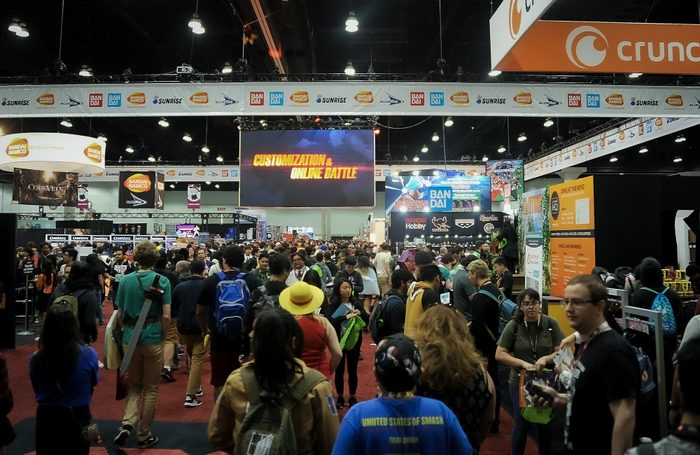
Most importantly, though, was that many anime voice actors — like Miller, who also worked on video games — saw for the first time that SAG-AFTRA was fighting for them. Dubbing actors approached the union in 2017, Miller says. They were told to hold tight.
After the strike, union organizers approached various voice actors, including Miller and McCarley, to help establish the Coalition of Dubbing Actors (CODA) as an advocacy group — a “backbone,” Miller explains — by and for dubbing voice actors to foment solidarity. To the frustration of CODA organizers, however, many actors conflate CODA with SAG-AFTRA, which leads to suspicion and distrust in a right-to-work state like Texas, the largest dubbing community outside of Los Angeles.
As actors started organizing in 2016 and 2017, Miller says, there were only around 16 union dubs in a year, which represented roughly 1 in 10 of Crunchyroll dubs released in those years. By 2021, there were about 200 union shows.
CODA also convinced SAG-AFTRA to create a dubbing steering committee, which helped the union reach an agreement with Netflix in 2019. This contract updated the ancient pay minimums and baked-in yearly increases, and it added an automatic 50% buyout (which, according to McCarley, increased the effective hourly rate to over $130). Updated terms, including pay bumps and vocal protections, are set to go into effect this year.
In 2021, that 2019 contract became the basis for the long-awaited update to the promulgated union contract. CODA then helped actors approach Aniplex, a Sony-owned production company, and convinced it to voluntarily switch to this union contract.
In 2022, after extensive community polling, CODA helped nonunion actors across the country negotiate increases to their own rates, including at Crunchyroll.
Bigger than God
By this time, many of the small, fan-run distribution companies had gone bust, while others were gobbled up by Sony — such as Funimation, acquired in 2017. In 2021, despite an antitrust review by the Justice Department, Funimation — under Sony — acquired Crunchyroll for $1.175 billion.
“They are possibly bigger than I can comprehend at this point,” Sean Chiplock says. Now, outside of Netflix, to enjoy basically any major anime title, you’ll need to join Crunchyroll’s 10 million (and counting) paying subscribers.
That growth, apparently, hasn’t trickled down. Crunchyroll voice actors have publicly complained of low pay. Funimation’s 2021 anime film Jujutsu Kaisen 0 grossed well over $30 million in the United States, but the actors who voiced some of the characters say they were paid $150.
“How can you manage to be so valuable,” says Chiplock, “and still pay rates like this?”
On the surface, $150 for a few hours of work may sound appealing, but “most of the time that we spend doing voiceover work,” Diskin explains, “is either unpaid or actually costing us money.” Actors need to find, prepare for and attend auditions; keep their skills fresh by going to classes; and, especially during the pandemic, shell out thousands of dollars for home studio equipment.
And fans tend to vastly overestimate how lucrative voice work is. Diskin recounts looking up his own supposed net worth online, and being shocked to find it at a supposed $5 million. “I’ve never seen a million dollars in my life,” he says. “We’re not a bunch of millionaires. We’re thousand-aires, at best. … Most just live paycheck to paycheck.”
Many actors make ends meet with appearances at anime conventions. What were once small gatherings of like-minded fans have ballooned into Crunchyroll-dominated corporate bonanzas that draw upward of 100,000 people. They’re a chance for actors to meet fans, attend and present panels, and sell merchandise — often prints of characters they’ve voiced.
Diskin likens this to being “a waiter in a restaurant who relies on tips.” Relying on convention income “transfers the responsibility of paying the actors from the people who actually make money off of these projects to the fans,” he says, “which I think is really unfair.”
Actors attached to the most popular characters can earn tens of thousands of dollars at a single convention. But even hit shows have short shelf lives, and the vast majority of actors don’t play “popular” characters.
Wrangling the Lone Star (State)
That competition between actors for hit roles “makes uniting [voice actors] a challenge and dividing us a breeze,” Diskin says. Any divide is a weak point that production can and does target. Older, established actors might fear being undercut by overeager young fans willing to work for cheap or free, for example. And unionized workers might resent being undercut by nonunion workers, while the latter can feel excluded from the union (which requires having worked a union show to qualify).
There’s also a longstanding divide between the two major dubbing communities, in Los Angeles and Texas. According to actors involved in CODA, when organizers ventured into Texas, they were met with distrust and fear. Actors in Texas are almost totally reliant on Crunchyroll for work and are therefore scared of rocking the boat. Even those who support initiatives like CODA, according to Diskin, don’t want that support made public.
Without union representation, actors remain vulnerable. In 2022, Crunchyroll sparked outrage when it demanded actors return to in-person recording, despite some of them being immunocompromised.
Crunchyroll executives seem determined to oppose the unionization that might give workers more power. Mob Psycho 100 is just the most recent example. Marin Miller says they previously worked on a show (which they did not name for fear of repercussions) that Crunchyroll produced with multiple other companies and prevented from being union despite all other parties being on board.
In the face of such conditions, the path forward is long and unclear. “I wish I knew” how to reach people, Miller says. “I’m trying so hard.”
“It is going to take a lot of work and a lot of basically the equivalent of trust fall exercises,” Diskin thinks, to convince Texas-based actors that CODA and the union are there to help.
Without solidarity within the dubbing community, anime voice actors effectively cannot strike like video game voice actors — though many remain hopeful that Crunchyroll can be won over through conversation.
Though distant, that victory would change the nature of the entire anime industry, McCarley explains. It “would let the translators and the directors and the writers — everybody — know that we can unionize.”
Rohan Montgomery is a former fact-checker and intern at In These Times. He previously worked for The New Republic, and his work has also appeared in the BBC. He tweets @RohanMontroro.
